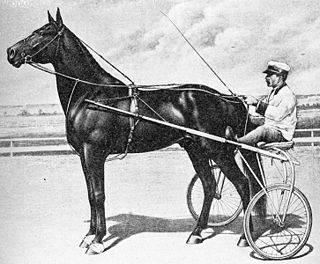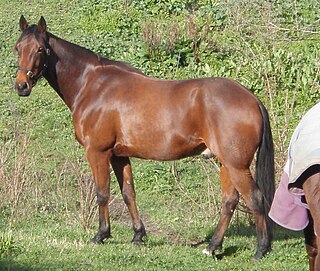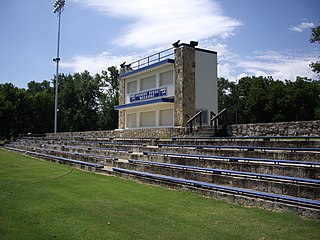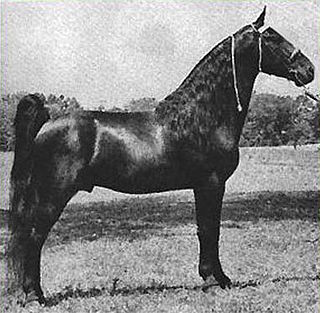Related Research Articles

Peabody is a city in Marion County, Kansas, United States. As of the 2020 census, the population of the city was 937. The city was named after F.H. Peabody of Boston, former vice-president of the Atchison, Topeka and Santa Fe Railway. Peabody is well known in the region for its Independence Day Celebration on July 4, and its historic 1880s downtown main street. It is located between Newton and Florence along U.S. Route 50 highway.

Dan Patch was a noted American Standardbred pacer. At a time when harness racing was one of the largest sports in the nation, Dan Patch was a major celebrity. He was undefeated in open competition, and was so dominant on the racetrack that other owners eventually refused to enter their horses against him. Instead, he ended his racing career performing time trials, and traveled extensively on exhibition, earning millions of dollars in purses, attendance gate receipts, and product endorsements. Dan Patch broke world speed records at least 14 times in the early 1900s. In 1905, he set a world's record for the fastest mile by a harness horse that stood unmatched for over 30 years. Unofficially, Dan Patch broke this record in 1906 with a clocking of 1:55. He died on July 11, 1916. His owner, Marion Willis Savage, died just one day later.

The Standardbred is an American horse breed best known for its ability in harness racing where they compete at either a trot or pace. Developed in North America, the Standardbred is recognized worldwide, and the breed can trace its bloodlines to 18th-century England. They are solid, well-built horses with good dispositions.

Adios was a champion harness racing sire. The son of Hal Dale and the mare Adioo Volo, the horse named Adios was born on January 3, 1940, at Two Gaits Farm, in Carmel, Indiana. Trained and driven by Frank Ervin and for a while owned by Harry Warner of Warner Bros. film studio, Adios was a multiple world champion during his racing career. His pacing record at the Shelbyville, Indiana, fair stood for 43 years. Despite his racing success, he is most famous for his offspring, which included Adios Harry.
Beach Towel was a Standardbred pacer who was named the 1990 American Harness Horse of the Year. He won 18 of his 23 starts with a fastest race mile of 1:50 and earnings of $2,091,860.

Messenger was an English Thoroughbred stallion imported into the newly formed United States of America just after the American Revolution. He is most famous for being the great-grandsire of Hambletonian 10, the father of all American Standardbred horses. Though he did not have a long racing career himself, he was a common ancestor in many successful racing horses into the 20th century.
Joe Patchen was a Standardbred racehorse foaled in Peabody, Kansas, United States. His sire was Patchen Wilkes and his dam was Josephine Young. Though best remembered for siring the famous Dan Patch, Joe Patchen enjoyed a successful racing career of his own: he was nicknamed "the iron race-horse of the age."

Hambletonian 10, or Rysdyk's Hambletonian, was an American trotter and a founding sire of the Standardbred horse breed. The stallion was born in Sugar Loaf, New York, on 5 May 1849. Hambletonian has been inducted into the Immortals category of the Harness Racing Hall of Fame.

Diomed (1777–1808) was an English Thoroughbred race horse who won the inaugural running of the Epsom Derby in 1780. Sold and imported to Virginia, he was subsequently a successful sire in the United States after the American Revolutionary War.

Mesaoud, an Arabian stallion, foaled 1887, was one of the foundation sires of the Crabbet Arabian Stud in England. Bred in Egypt by Ali Pasha Sherif, he was imported to England by Wilfred and Lady Anne Blunt in 1891. He is recognized as an Al Khamsa Arabian, with verifiable lineage tracing to the Bedouin of the desert.
Two Gaits Farm is the name of a Standardbred horse farm that functioned from 1934-1973. It belonged to Leo C. McNamara, Sr. and at one time was internationally known as the largest standardbred pacer breeding farm in the country. The farm was the birthplace of numerous famous horses over the years. In the early 1950s there were over 500 horses being cared for on the farm.

Eleanor was a British Thoroughbred racehorse bred by Charles Bunbury and was the first female horse to win The Derby. Eleanor also won the 1801 Epsom Oaks among many other races before retiring from racing at age eight to become a broodmare for Bunbury. She produced the stallion Muley, which in turn sired the mare Marpessa and the influential stallion Leviathan which was exported to the United States in the early nineteenth century. Through the produce of her daughter Active, Eleanor is present in the pedigrees of 19th-century American Standardbred racehorses.

Peabody City Park was listed on the National Register of Historic Places (NRHP) in 2012, and the sixth NRHP listing in Peabody, Kansas, United States. The park is approximately 3 blocks by 2 blocks in size and located in southwest Peabody.

Bingen (1893–1913) was an American Standardbred horse. A descendant of Hambletonian 10, he is considered one of the most important sires in the development of the modern Standardbred breed.

Peter the Great (1895–1923) was an American Standardbred horse. A descendant of Hambletonian 10, he is considered one of the most important sires in the development of the modern Standardbred breed.
Axworthy (1892–1917) was an American Standardbred horse. A descendant of Hambletonian 10, he is considered one of the most important sires in the development of the modern Standardbred breed.

Black Allan or Allan F-1 was the foundation sire of the Tennessee Walking Horse. He was out of a Morgan and Thoroughbred cross mare named Maggie Marshall, a descendant of Figure and the Thoroughbred racing stallion Messenger; and sired by Allandorf, a Standardbred stallion descended from Hambletonian 10, also of the Messenger line.

Midnight Sun (1940–65) was one of the leading sires of the Tennessee Walking Horse breed, and a two-time World Grand Champion in 1945 and 1946. He was trained by Fred Walker and lived almost all his life at Harlinsdale Farm in Franklin, Tennessee.
Wiking is the all-time leading sire of Arabian racehorses. Born in Poland in 1979, Wiking was imported to the United States in 1984. He raced 37 times total, 18 in Poland with 8 wins, and then 20 starts in the United States with 12 wins, and earned $97,782 in US dollars. He was owned by Town and Country Farms and trained by Robert Knight.
Lindy's Pride was an American Standardbred racehorse and sire. He won the Triple Crown of Harness Racing for Trotters as a three-year-old in 1969 but was retired owing to chronic hoof problems a year later. He later became a successful breeding stallion.
References
- ↑ "The Peabody Gazette-Herald 29 Sep 1887, page 5". Newspapers.com. Retrieved 2022-12-30.
- 1 2 3 "The Peabody Gazette-Herald 28 Oct 1886, page 4". Newspapers.com. Retrieved 2022-12-30.
- 1 2 3 "The Kansas City Times 11 May 1982, page 18". Newspapers.com. Retrieved 2022-12-31.
- 1 2 3 4 "The Peabody Herald 14 Dec 1911, page 4". Newspapers.com. Retrieved 2022-12-31.
- ↑ Bailey, Liberty Hyde (1908). Cyclopedia of American Agriculture: Animals. Macmillan.
- ↑ "Star Tribune 16 Dec 1958, page Page 19". Newspapers.com. Retrieved 2022-12-31.
- 1 2 Agriculture, Kansas State Board of (1901). Report.
- ↑ "Cedar Vale Commercial 19 Jan 1900, page 1". Newspapers.com. Retrieved 2022-12-31.
- 1 2 3 4 5 "The Peabody Weekly Republican 17 Feb 1888, page 4". Newspapers.com. Retrieved 2022-12-30.
- ↑ "The Weekly Republican 20 Jan 1888, page 5". Newspapers.com. Retrieved 2022-12-31.
- 1 2 "The Peabody Weekly Republican 08 Aug 1895, page 2". Newspapers.com. Retrieved 2022-12-31.
- ↑ "The Peabody Weekly Republican 20 Jun 1890, page 5". Newspapers.com. Retrieved 2022-12-30.
- ↑ "Halstead Independent 28 Sep 1905, page 1". Newspapers.com. Retrieved 2022-12-31.
- ↑ "The Peabody Weekly Republican 13 Jan 1888, page 5". Newspapers.com. Retrieved 2022-12-30.
- ↑ "Halstead Independent 30 Apr 1886, page 3". Newspapers.com. Retrieved 2022-12-30.
- ↑ "Hillsboro Herald 30 Aug 1888, page 2". Newspapers.com. Retrieved 2022-12-30.
- ↑ "The Peabody Gazette-Herald 12 Nov 1896, page 4". Newspapers.com. Retrieved 2022-12-31.
- ↑ "The Leader Courier 04 Dec 1890, page Page 6". Newspapers.com. Retrieved 2022-12-31.
- ↑ "Harness Racing in Kansas - Kansapedia - Kansas Historical Society". www.kshs.org. Retrieved 2022-12-30.
- 1 2 "The Saint Paul Globe 03 Jan 1887, page Page 9". Newspapers.com. Retrieved 2022-12-31.
- ↑ "Joe Young Standardbred". www.allbreedpedigree.com. Retrieved 2022-12-31.
- ↑ "Hambletonian Standardbred". www.allbreedpedigree.com. Retrieved 2022-12-31.
- ↑ "Joe Young Standardbred" . Retrieved 31 December 2022.